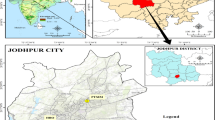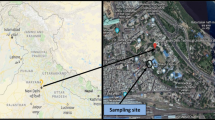Abstract
The present study deals with the effect of fireworks on ambient air quality during Diwali Festival in Lucknow City. In this study, PM10, SO2, NO x and 10 trace metals associated with PM10 were estimated at four representative locations, during day and night times for Pre Diwali (day before Diwali) and Diwali day. On Diwali day 24 h average concentration of PM10, SO2, and NO x was found to be 753.3, 139.1, and 107.3 μg m−3, respectively, and these concentrations were found to be higher at 2.49 and 5.67 times for PM10, 1.95 and 6.59 times for SO2 and 1.79 and 2.69 for NO x , when compared with the respective concentration of Pre Diwali and normal day, respectively. On Diwali day, 24 h values for PM10, SO2, and NO x were found to be higher than prescribed limit of National Ambient Air Quality Standard (NAAQS), and exceptionally high (7.53 times) for PM10. On Diwali night (12 h) mean level of PM10, SO2 and NO x was 1,206.2, 205.4 and 149.0 μg m−3, respectively, which was 4.02, 2.82 and 2.27 times higher than their respective daytime concentrations and showed strong correlations (p<0.01) with each other. The 24 h mean concentration of metals associated with PM10 was found to be in the order of Ca (3,169.44)>Fe (747.23)>Zn (542.62)>Cu (454.03),>Pb (307.54)>Mn (83.90)>Co (78.69)>Cr (42.10)>Ni (41.47)>Cd (34.69) in ng m−3 and all these values were found to be higher than the Pre Diwali (except Fe) and normal day. The metal concentrations on Diwali day were found to be significantly different than normal day (except Fe & Cu). The concentrations of Co, Ni, Cr and Cd on Diwali night were found to be significantly higher than daytime concentrations for Pre Diwali (control). The inter correlation of metals between Ca with Pb, Zn with Ni and Cr, Cu with Co, Co with Mn, Ni with Cd, Mn with Cd, Ni with Cd and Cr, and Cr with Cd showed significant relation either at p<0.05 or P<0.01 levels, which indicated that their sources were the same. The metals Cu, Co, Ni, Cr and Cd showed significant (p<0.01) association with PM10. These results indicate that fireworks during Diwali festival affected the ambient air quality adversely due to emission and accumulation of PM10, SO2, NO x and trace metals.
Similar content being viewed by others
References
ATSDR (Agency for Toxic Substances and Disease Registry) (2002). Toxicological profile of Copper. Atlanta, GA, USA: Division of Toxicology.
ATSDR (Agency for Toxic Substances and Disease registry) (2003). Toxicological profile information sheet. http://www. Atsdr.cdc.gov./toxiprofiles.
Attri, A. K., Kumar, U., & Jain, V. K. (2001). Formation of ozone by fireworks. Nature, 411, 1015.
Bach, W., Daniels, A., Dickinson, L., Hertlein, F., Morrow, J., Margolis, S., et al. (1975). Fireworks pollution and health. International Journal of Environmental Studies, 7, 183–192.
Barnett, A. G., Williams, G. M., Schwartz, J., Nekker, A. H., Best, T. L., Petriescgevsjt, A. L., et al. (2005). Air pollution and child respiratory health: A case-crossover study in Australia and New Zealand. American Journal of Respiratory and Critical Care Medicine, 171, 1272–1278.
Benoff, S., Jacob, A., & Hurley, I. R. (2000). Male infertility and environmental exposure to lead and cadmium. Human Reproduction Update, 6, 107–121.
Chen, L. H., Knutsen, S. F., Shavlik, D., Beeson, W. L., Peterson, F., Ghamsary, M., et al. (2005). The association between fatal coronary heart disease and ambient particulate air pollution: Are females at greater risk? Environmental Health Perspectives, 113,1723–1729.
Curtis, L., Rea, W., Smith-Willis, P., Fenyves, E., & Pan, Y. (2006). Adverse health effects of outdoor air pollutants. Environmental International, 32, 815–830.
Dockery, D. W., Luttnabb-Gibson, H., Rich, D. Q., Link, M. L., Mittleman M. A., Gold, D.R., et al. (2005). Association of air pollution with increased incidence of ventricular tachyarrythmias recorded by implanted cardioverter defibrillators. Environmental Health Perspectives, 113, 670–674.
Dockery, D. W., Pope, C. A., Xu, X., Spengler, J. D., Ware, J. H., Fay, M. E., et al. (1993). An association between air pollution and mortality in six US cities. New England Journal of Medicine, 329, 1753–1759.
Drewnick, F., Hings, S. S., Curtius, J., Eerdekens, G., & Williams, J. (2006). Measurement of fine particulate and gas-phase species during the New Year’s fireworks 2005 in Mainz, Germany. Atmospheric Environment, 40, 4316–4327.
Dutcher, D. D., Perry, K. D., Cahill, T. A., & Copeland, S. A. (1999). Effects of indoor pyrotechnic displays on the air quality in the Houston Astrodome. Journal of the Air & Waste Management Association, 49, 156–160.
Fang, G. C., Wu, Y. S., Huang, S. H., & Rau, J. Y. (2005). Review of atmospheric metallic elements in Asia during 2000–2004. Atmospheric Environment, 39, 3003–3013.
Gupta, A., Kumar, R., Kumari, K. M., & Srivastava, S. S. (2003). Measurement of NO2, HNO3, NH3 and SO2 and related particulate matter at a rural site in Rampur, India. Atmospheric Environment, 37, 4837–4846.
Hirai, K., Yamazaki, Y., Okada, K., Furuta, S., & Kubo, K. (2000). Acute eosinophilic pneumonia associated with smoke from fire works. Internal Medicine (Japan), 39(5), 401–403.
Hu, H. (2002). Human health and heavy metals exposure. In M. McCally (Ed.), Life support: The environment and human health. MIT Press.
Indian Standard (1975). Methods for measurement of air pollution — Part VI: nitrogen oxides. IS 5182. Bureau of Indian Standard, New Delhi.
Indian Standard (2001). Methods for measurement of air pollution — Part 2: sulphur dioxide. IS 5182. Bureau of Indian Standard, New Delhi.
Kisku, G. C., Salve, P. R., Kidwai, M. M., Khan, A. H., Barman, S. C., Singh, R., et al. (2003). A random survey of ambient air quality in Lucknow City and its possible impact on environmental health. Indian Journal of Air Pollution Control, 3(1), 45–48.
Kulshrestha, U. C., Rao, T. N., Azhaguvel, S., & Kulshrestha, M. J. (2004). Emissions and accumulation of metals in the atmosphere due to crackers and sparkles during Diwali festival in India. Atmospheric Environment, 38, 4421–4425.
Liu, S., Knewski, D., Shi, Y., Chen, Y., & Burnett, R. T. (2003). Association between gaseous ambient air pollutants and adverse pregnancy outcomes in Vancouver, British Columbia. Environmental Health Perspectives, 111, 1773–1778.
Liu, D. Y., Rutherford, D., Kinsey, M., & Prather, K. A. (1997). Real-time monitoring of pyrotechnically derived aerosol particles in the troposphere. Analytical Chemistry, 69, 1808–1814.
Manalis, N., Grivas, G., Protonotarios, V., Moutsatsou, A., Samara, C., & Chaloulakou, A. (2005). Toxic metal content of particulate matter (PM10), within the greater area of Athens. Chemosphere, 60(4), 557–566.
Mandal, R., Sen, B. K., & Sen, S. (1997). Impact of fireworks on our environment. Indian Journal of Environmental Protection, 17, 850–853.
Maynard, A. D., & Kuempel, D. K. (2005). Airborne nanostructured particles and occupational health. Journal of Nanoparticle Research, 7, 587–514.
Morawska, I., Jayaratne, E. R., Mengersen, K., Jamriska, M., & Thomas, S. (2002). Differences in airborne particle and gaseous concentration in urban air between weekdays and weekends. Atmospheric Environment, 36, 4375–4383.
Peters, A., Von Klot, S., Heier, M., Trentinaglia, I., Horman, A., Wichmann, E., et al. (2004). Exposure to traffic and the onset of myocardial infarction. New England Journal of Medicine, 351, 1721–1730.
Pope, C. A., Thyb, M. J., & Namboodiri, M. M. (1995). Particulate air pullution as a predictor of mortality in a prospective study of US adults. American Journal of Respiratory and Critical Care Medicine, 151, 669–674.
Ravindra, K., Mor, S., & Kaushik, C. P. (2003). Short-term variation in air quality associated with firework events: A case study. Journal of Environmental Monitoring, 5, 260–264.
Ristovski, Z. D., Morawska, L., Bofinger, N. D., & Hitchins, J. (1998). Submicrometer and supermicrometer particulate emission from spark ignition vehicles. Environmental Science and Technology, 32, 3845–3852.
Santos-Burgoa, C, Rios, C., Nercadi, L. A., Arecguga-Serrano, R., Cano-Vall, F., Eden-Wynter, R. A., et al. (2001). Exposure to manganese; health effects on the general population, a pilot study in central Mexico. Environ Res. Sect A, 85, 90–104.
Schwartz, J., Dockery, D. W., & Neas, L. M. (1996). Is daily mortality associated specifically with fine particles? Journal of the Air and Waste Management Association, 46, 927–939.
Sharma, K., Singh, R., Barman, S. C., Mishra, D., Kumar, R., Negi, M. P. S., et al. (2006) Comparison of trace metals concentration in PM10 of different location of Lucknow city. Bulletin of Environmental Contamination and Toxicology, 77, 419–426.
Wang, X., Bi, X., Sheng, G., & Fu, J. (2006) Hospital indoor PM10/PM2.5 and associated trace elements in Huangzhou, China. Science of the Total Environment, 366, 124–135.
Yasutake, A., & Hirayama, K. (1997) Animal models. In E. J. Massaro (Ed.), Handbook of human toxicology. Boca Raton, New York: CRC.
Ye, F., Piver, W. T., Ando, M., & Portier, C. J. (2001). Effects of temperature and air pollutants on cardiovascular and respiratory diseases for males and females older than 65 years of age in Tokyo, July and August 1980–1995. Environmental Health Perspectives, 109, 355–359.
Zanobetti, A., & Schwartz, J. (2002). Cardiovascular damage by airborne particles: Are diabetics more susceptible? Epidemiology, 13, 588–592.
Zar, J. H. (1974). Biostatistics analysis. Englewood Cliffs, N. J.: Prentice Hall. Anon Cem Eg Newa 49, 29.
Author information
Authors and Affiliations
Corresponding author
Additional information
ITRC Communication Number 2538
Rights and permissions
About this article
Cite this article
Barman, S.C., Singh, R., Negi, M.P.S. et al. Ambient air quality of Lucknow City (India) during use of fireworks on Diwali Festival. Environ Monit Assess 137, 495–504 (2008). https://doi.org/10.1007/s10661-007-9784-1
Received:
Accepted:
Published:
Issue Date:
DOI: https://doi.org/10.1007/s10661-007-9784-1




